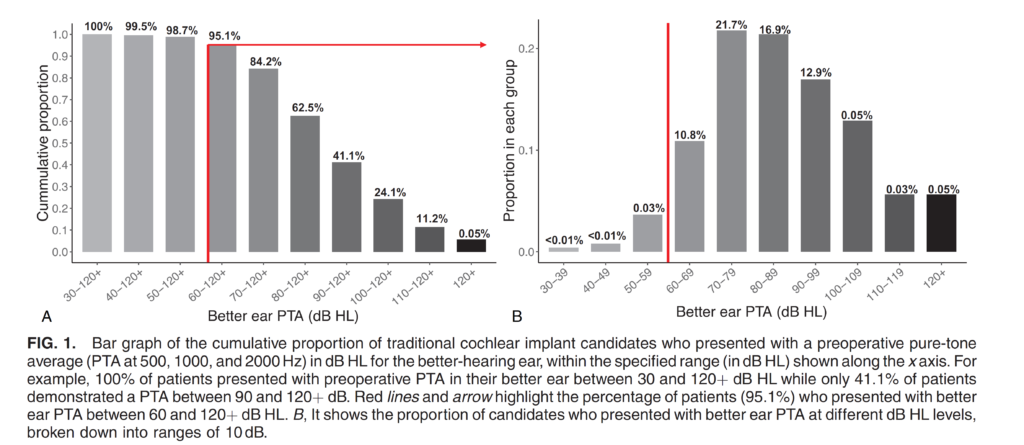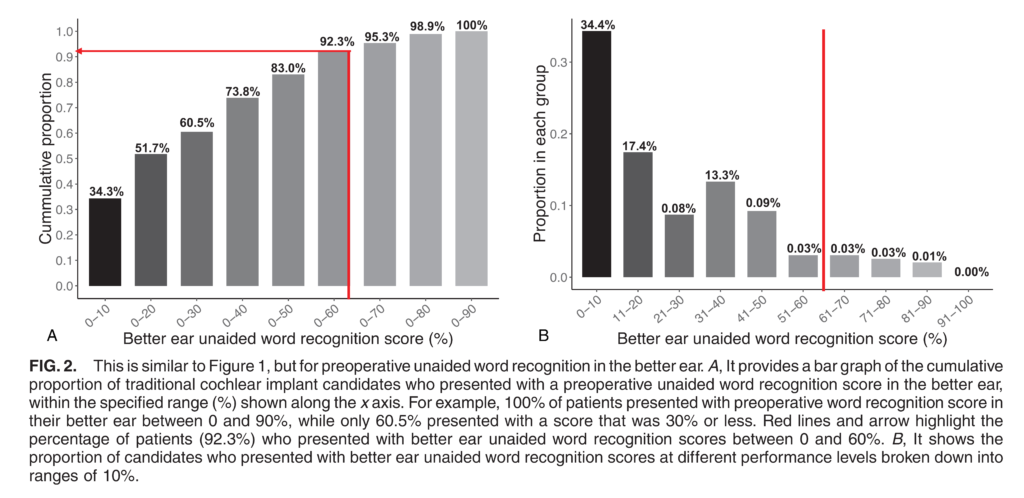By Duncan Meldrum, Senior Manager of Professional Engagement at Cochlear
Development of a 60/60 Guideline for Referring Adults for a Traditional Cochlear Implant Candidacy Evaluation
Zwolan, Teresa A.; Schvartz-Leyzac, Kara C.; Pleasant, Terrence
Department of Otolaryngology, Head and Neck Surgery
Michigan Medicine
Otology & Neurotology
In today’s busy clinical environment, clinicians who value research-based practice often struggle to keep up with current literature. To help, we’re excited to offer a Cochlear ProNews monthly feature – Journal Club! Each month, rotating guest authors will present a current journal article summary that provides clinical insights.
This month’s Journal Club explores a recent U.S. study published in Otology & Neurotology, Development of a 60/60 Guideline for Referring Adults for a Traditional Cochlear Implant Candidacy Evaluation (CICE).
What did the study investigate?
This study involved a retrospective data review to evaluate the effectiveness of a referral guideline for cochlear implant candidacy evaluations (CICE). The study proposes and demonstrates the effectiveness of implementing a 60/60 referral guideline, whereby the patient demonstrates a best ear unaided monosyllabic word score less than or equal to 60% correct, as well as an unaided pure-tone average in their better ear that is greater than or equal to 60 dB HL. It compared the highest preoperative unaided monosyllabic word recognition score in the right and left ears. The group also wanted to examine both “hit” and “miss” rates when using the guideline and therefore looked at candidates and non-candidates.
Why is this important?
Overall, awareness and access surrounding cochlear implants for the general population is poor and evidence-based criteria regarding when to refer is lacking. Proposed reasons for such a low percentage of adult candidates receiving a cochlear implant include a lack of routine hearing screening for adults as well as a lack of awareness regarding candidacy criteria amongst primary care physicians, community audiologists and the general population.1 There is also a lack of referral guidelines for dispensing audiologists due to differences in test procedures used by referral sources and CI clinics. This study proposes a guideline that would be clinically useful for referring clinicians to identify patients that may be cochlear implant candidates while aligning with the criteria typically used in a CI clinic.
How did they do it?
Authors reviewed the medical records of 661 adults who participated in a CICE at the University of Michigan between January 2016 and September 2019. 250 adults met traditional indications for a CI while 279 did not meet traditional indications for a CI. Note that 132 were removed from analysis.
The group then examined preoperative data for candidates and non-candidates including unaided thresholds for each ear and best unaided monosyllabic word recognition score, comparing the right and left ears.
Results2
Of the 661 adult patients reviewed, 38% (250) met traditional cochlear implant indications.* Of these patients, 95% had a preoperative PTA in their better hearing ear that was greater than or equal to 60 dB with the majority falling between 70 and 89 dB hearing loss. This same patient group demonstrated a mean unaided best monosyllabic word score of 25% correct.
Figure 1 shows the preoperative unaided better ear Pure Tone Average (PTA) in traditional candidates. As the PTA goes up, the cumulative percentage goes down. Moreover, 95% of patients presented with a better ear PTA>60 dB and a vast majority of patients had a PTA much >60 dB.

Figure 2 shows the best unaided word recognition score of the traditional candidates. As the word score goes down the cumulative percentage goes down, leading the authors to conclude that patients with an unaided word recognition score in their better ear of less than 60% will likely be a candidate for a CI.
60/60 Referral Guideline
The data in this study showed that patients are very likely to qualify for a CI if they demonstrate a PTA in the better ear ≥60dB HL and a better ear monosyllabic word score of ≤60%. When examined as a screening tool for cochlear implant candidacy, the 60/60 guideline demonstrated a sensitivity (detection rate) of 96.3%, and a specificity rate of 65.6% (false-positive rate of 34%). Based on these findings, the authors believe that patients should be referred for a CICE if they meet the 60/60 guideline.

Discussion
One possible reason for under-referral may be the difference in test procedures used by referring professionals and audiologists who perform CICEs. Non-performing professionals often indicate they prefer to recommend a patient for a CICE only when they are certain of candidacy. The 60/60 guideline provides professionals with justification for such referrals based on the data set.
In summary, the group recommends that patients be considered for a CICE if they obtain a score less than or equal to 60% correct on an unaided monosyllabic word test in the better ear and if they demonstrate a PTA greater than or equal to 60 dB HL. It should be noted that this guideline only refers to traditional candidates. The group is hopeful that this simple guideline will result in an increase in the number of patients who are referred for a traditional cochlear implant candidacy evaluation.
Learn more by accessing the publication and stay tuned for next month’s edition of Journal Club!
References:
1. Sorkin and Buchman, 2015
2. Zwolan, Teresa A.; Schvartz-Leyzac, Kara C.; Pleasant, Terrence Development of a 60/60 Guideline for Referring Adults for a Traditional Cochlear Implant Candidacy Evaluation, Otology & Neurotology: April 20, 2020 – Volume Publish Ahead of Print – Issue – doi: 10.1097/MAO.0000000000002664


* This is a summary of a study conducted to assess guidelines for referrals for cochlear implant evaluations. Guidelines for referrals are not the same as indications. The “traditional indications” outlined in this study are not identical to Cochlear’s FDA-approved indications, which are: The Nucleus 24 Cochlear Implant System is intended for individuals 18 years of age or older who have bilateral, pre, peri or postlinguistic sensorineural hearing impairment and obtain limited benefit from appropriate binaural hearing aids. These individuals typically have moderate to profound hearing loss in the low frequencies and profound (≥90 dB HL) hearing loss in the mid to high speech frequencies. Limited benefit from amplification is defined by test scores of 50% correct or less in the ear to be implanted (60% or less in the best-aided listening condition) on tape-recorded tests of open set sentence recognition.


